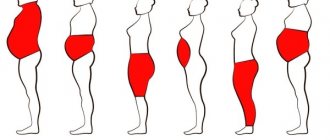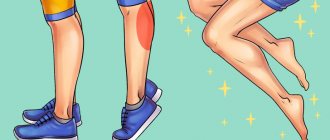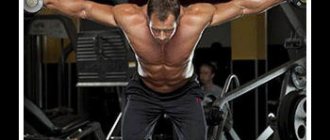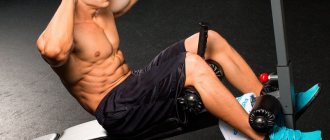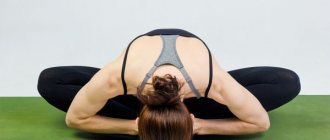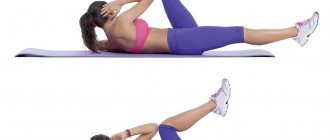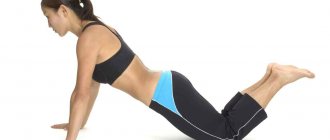Plank on fitlopto
Place your forearms on a stability ball with your shoulders over your elbows, toes, feet together or hip-width apart, knees bent, hips down, and your entire body in a straight line. Inhale and prepare to exhale as you straighten your knees and hips into a plank position . Hold for a few breaths. Exhale and lower your knees to the starting position. Do 5 – 8 repetitions . This is what it should look like:
Exercise 1
The exercise effectively works all the abdominal muscles.
Starting position: sit on a fitball, feet flat on the floor, cross your arms over your chest. Stepping your feet, carefully lower yourself forward so that your back is on the ball and your knees are under your ankles, keeping your head up without leaning back. From this position, using an isolated effort of the abdominal muscles, begin a slow twist: first the head, then the shoulders, then the middle of the back until you feel a complete contraction of the abdominal muscles. Emphatically slowly return to the starting position.
At the initial stage, start with 1-2 sets of 8-10 repetitions each. Rest between sets for 45 seconds.
Execution option for beginners
When you can easily master this exercise, move on to a more advanced version.
The starting position is the same, with only one exception - the arms are bent at the elbows and placed on the back of the head, do not cross the fingers. Performing the exercise is similar to the option described above. At this stage, perform the exercise in 3 sets of 12 repetitions each. Reduce rest between sets to 30 seconds.
Execution option for advanced
The third option is even more difficult; move on to it only when you can easily perform the second option of the exercise.
The starting position is the same, with only one exception - the arms are straightened behind the head so that they are located close to the ears, in the hands is a medicine ball (can be replaced with a dumbbell weighing 1-3 kilograms or weights can be used). At this stage, perform the exercise in 2-3 sets of 12-15 repetitions each. If you don’t want to use weights, simply perform the exercise with your arms extended behind your head: 4 sets, first 15, then 20 repetitions. Do not bend your arms while doing this.
Complicated version
“Plank” with emphasis on the knees
Your knees also need a stretch from time to time. Start in a plank position and place an exercise ball under your shins. The body forms a straight line from the shoulders to the ankles. Exhale. Pull the exercise ball toward your hands, bending your knees toward your chest. Breathe in. Place the stability ball back and return to the plank position. Repeat 15-20 times.
Exercise 6
The exercise works all the abdominal muscles, but mainly the transverse and oblique internal muscles.
Starting position: lie on the floor, place your arms straight behind your head, and hold the exercise ball between your calves.
From this position, tighten your abs, which will bring your spine into a neutral position. Then inhale, bend your knees slightly and lift the exercise ball with your feet 45° from the floor. Exhaling slowly in five counts, using your abdominal muscles, lift your shoulders and head and reach your hands towards the ball. Continuing to keep your legs suspended, lower your head and shoulders to the starting position. Then lower your legs. This will be one repetition.
At the initial stage, start with 1 set of 10 repetitions. As muscle strength develops, increase the number of sets to 2 and the number of repetitions to 12-15 each.
Be sure to rest 30 seconds to 1 minute between sets.
Hitch
At the end of a set of exercises, be sure to stretch to avoid injury and unnecessary muscle pain. And stretching on the ball is double pleasure. First, it bears your body weight, helping you relax. Secondly, it helps relieve stress from the joints.
High Plank Hip Extension
This intense exercise from Ella Magers of Sexy Fit Vegan requires not only strong abdominal muscles, but also good balance. Start in a plank position with your feet on an exercise ball and your hands on the floor. Make sure your hands are directly under your shoulders. For balance, tighten your abdominal muscles. Raise your right leg about 15 centimeters from the ball. Stay in this position for a few seconds, then slowly return to the starting position, then repeat the movement with your left leg. Keep your leg straight (without bending your knee). Repeat as many times as you can.
Exercises with a fitball for the abs
Exercises with a fitball initially affect posture and muscle corset. And the latter includes the abdominal muscles. If it is trained, it allows you to protect the spine, ensure correct posture, and a beautiful gait.
Those who want to have beautiful and strong abs should definitely buy a fitball and start working out with it. Of course, you shouldn’t limit yourself to just these activities, because variety is the most enjoyable and effective. But knowing how to properly pump your abs on a fitball, you will give yourself the opportunity to achieve excellent results.
The best abdominal exercises on a fitball
Let's look at the best abdominal exercises on a fitball, which will be very useful for the abdomen and waist.
1. Rifles
A very difficult but effective abdominal exercise on a fitball, which will give you the opportunity to warm up, so it is recommended to use it at the beginning of the lesson.
Place your arms straight on the floor. The face should be directed downwards, the legs (preferably only the feet) should rest on the ball. Slowly begin to move your hands backwards so that the ball rolls forward and ends up under your stomach or chest. It is advisable not to lower your legs to the floor, but to keep them raised. Roll back so the ball is under your feet. It is important to try to keep your balance and not roll off the fitball. Do the exercise as many times as you can until you get tired.
2. Crunches
Ab crunches on a fitball are done as follows. You need to sit on the ball, keep your back straight, legs slightly apart. The feet should rest on the floor. Sink down the ball so that your shoulder blades rest on it and your legs move forward. Then clasp your hands at the back of your head and begin pumping your abs. Legs should be at right angles.
This exercise can be done with additional equipment, such as a small ball or dumbbells in your hands. In this case, when you lower your upper body, your hands should go behind your head or down to your chest. When twisted, they should stretch upward.
In the process of unwinding, you do not need to arch too much and throw your head back. It is advisable to do at least 20-30 twists.
3. Crunches with turns
This exercise can be performed without a fitball and is known as the “Russian twist.” It is effective for the oblique abdominal muscles. How to pump up your abs on a fitball with this exercise? The starting position is similar to the previous exercise. Hands need to be spread to the side. On the count of one, lift your shoulder blades off the ball, turn your body to the left and bring your hands together. On the count of two, return to the starting position. Then, on the count of three, repeat the turn, but in the other direction. On the count of four, return to the starting position. It is recommended to make at least 10-15 turns in both directions.
There is also a more complicated option. It involves making turns without letting your shoulder blades drop onto the ball. In this case, the tension will be greater, and accordingly, the performance will be higher.
4. Crunches with leg raises
With equipment like a stability ball, abdominal exercises in the crunch category can be just that. Lie down on the mat with your feet on the ball. The legs can be either straight or bent. It is recommended to do both options, as the load will be slightly different. Place your feet on the ball. Bend your elbows and place them on the back of your head. Pull your stomach in. Lift your shoulders off the floor and stretch your body towards your hips, then lower your shoulder blades and head towards the floor. Thus, we do regular crunches until a burning sensation is felt in the abdominal muscles.
5. Oblique Crunch
You need to take the same starting position as in the previous exercise. Lifting your shoulders off the floor, you should turn your body slightly to the side, and with the hand of the opposite side, reach towards your knee. The body turns to the right, the left hand comes off the head and touches the shin or knee. Then she returns behind her head, and immediately turns to the left side, lifting her right hand away from her head. The shoulder blades should not touch the floor - this will help maintain tension.
Repeat 15 times in both directions in one approach. If desired, you can perform 1-2 more approaches.
6. Hyperextension
Lower abdominal exercises on a fitball often include hyperextension. It also perfectly trains the back muscles.
You need to lie face down on the fitball. The ball should be under the fat and thighs. Bend your arms at the elbows and place them on the back of your head. The toes of the feet should rest on the floor. The body should be a straight line. Bend your body down, then lift it as high as possible. Then return to the starting position, where the body and legs are a straight line. Repeat the exercise this way: tilt your body - raise it - return to a straight line.
Hyperextension on a fitball is quite difficult to do, because you need to constantly maintain balance. But over time, you will adapt when the muscle corset is trained. It is recommended to do 2-3 sets of 10 repetitions.
7. Double crunches
You need to lie down on the mat with your back down, holding the fitball with your feet. Stretch your legs and keep them on the floor. Hands behind your head. Perform a twist - lift your shoulders off the floor and at the same time lift your legs with meat. Then unwind. Legs can be straight or bent. Don't rush and hold your breath. Do 10 repetitions in one approach. There can be 2-3 approaches in total.
8. Double crunches with fitball transfer
Abdominal exercises on a fitball, the video of which will help you understand how to perform them, also include crunches, which are very complex and effective. Lie down on the mat, take the fitball in your hands and place them behind your head. Stretch your legs, lift them a few centimeters above the surface. Inhaling, lift your shoulders off the floor, stretch your body and arms towards your legs. Raise your legs at the same time. As you exhale, you need to pass the ball from your hands to your feet and spin. Stretch your empty arms behind your head again. Raise your body again and pass the ball from your feet to your hands. Continue in this manner: twist, pass the ball, unwind. Repeat until you get tired.
9. Push-ups with a fitball
Push-ups are beneficial not only for the muscles of the back, shoulders, arms and chest. They also put a load on the abdominal muscles, and if you do push-ups from the floor on a ball, this load will be many times higher, so abs on a fitball in pictures often includes this exercise. Perform as standard, but your feet should rest against the ball. That is, you need to perform inclined push-ups, more complex than regular ones. With this exercise, the muscles will work at full strength.
To simplify the exercise, you can rest your knees on the ball. To make it more difficult, push only part of your shin and feet. Repeat as much as you can.
10. Unwinding
A fitball can act as a roller for the press. The effect will be slightly different, but very strong. We pump up the press on a fitball like this: sit on your knees on the mat, put the ball in front of you and rest your hands on it with your hands clenched into fists. First, bend your arms a little. Place them on the ball closer to you. Maintaining balance, roll the ball forward from you, while spinning and stretching. You need to extend your arms completely. Do not lie on the ball with your chest - only your hands should be on it. Your knees should still be on the floor. When you stretch out, stay in this position for 5-10 seconds. Twist again, rolling the ball back. When performed correctly, you will feel the tension in the abdominal muscles and their stretching. Do as much as you can. The exercise is relatively easy and can replace stretching. Ideal as a cool down at the end of class.
Exercises on a fitball are fun and effective. By regularly performing this complex, you will soon notice obvious results. The main thing is not to be lazy. If it’s difficult to understand from pictures and photographs how to pump up your abs on a fitball, videos on the relevant topic will help you figure it out one hundred percent. Videos of abs with a fitball can easily be found on the Internet and, by exercising with their help, you can fulfill your dream of a beautiful sculpted belly and thin waist.
See also Exercises for the back on a fitball
Leg raise exercise
Kathy Corey Pilates, one of the original founding companies of Pilates, shared this fun and effective exercise . To begin, lie on a fitball, placing it below your stomach, with your legs straight. Place your hands on the floor and move forward until the ball is below your hips. Your fingertips should point inward. Lower your arms and lift your legs towards the ceiling. Spread your legs wider than your hips. Raise and lower your legs with small, quick strokes, then bring your legs together, lowering them low to the level of the ball. Straighten your arms and walk backward until the ball is below your torso. It's funny, isn't it? Repeat 10 – 20 times.
Exercises for women on a fitness ball
Abdominal training is recommended to begin with general strengthening fitness techniques for all muscle groups.
What you can do to warm up on a fitball:
- You need to lie on the fitball with your back so that it is under your lower back. Hands are placed behind the back of the head, and the pelvis is fixed in the accepted position. Then you need to set your body in motion, trying to easily roll the fitball on the floor.
- You need to kneel down with a large ball under your chest and stomach. Hands should be on the floor. As you inhale, you need to raise your left arm and right leg, and as you exhale, return to the starting position. The same is done with the right hand and the opposite leg.
- Lie on the floor with your feet on the ball. Having relaxed your back muscles, you need to alternately roll up and roll away the fitball.
Side Twists (Single Leg Teaser with a Twist)
To begin, lie on your back, holding the exercise ball above you with both hands, keeping your legs straight and together. Rotate your torso, extend the ball forward, and lift one leg off the ground. Bend the knee of the raised leg while rotating your torso to rotate it in the direction of the bent knee. Keep the other leg firmly planted on the ground. Straighten your raised leg and lower yourself a few inches. Repeat the movement three more times on the same side and switch legs. Here's how Pilates Anytime trainers do this exercise.
Exercise 3
The exercise effectively works all the abdominal muscles and also engages the hip flexors.
Starting position: Lie on your back and hold the exercise ball between your ankles, legs straight. Place your hands behind your head and grab any support.
From this position, tightening your abdominal muscles and holding the ball firmly with your feet, pull your knees towards your chest. Then lift your buttocks off the floor. Hold this position for 1-2 seconds, then slowly return to the starting position.
At the initial stage, start with 1-2 sets of 12-15 repetitions each. As muscle strength develops, increase the number of sets to 3-4 and the number of repetitions to 20. Be sure to rest between sets: at the initial stage, 30 seconds - 1 minute, at a more advanced stage, reduce the rest time to a minimum.
Attention: lift your legs only with the force of your abdominal muscles; when performing, try to avoid arching in the lower back; To increase the load, use ankle weights, but reduce the number of repetitions to 12.
Exercise 4
The exercise effectively works all the abdominal muscles, engages the muscles of the buttocks, mid-back, as well as the hip flexors and hamstrings.
Starting position: get down on your knees, body and hips perpendicular to the floor, hands clasped. Without changing the position of your hips, place both hands on the exercise ball. From this position, begin to roll the ball forward. When the body angle approaches 45 degrees, stop, take a deep breath, draw in your stomach and, maintaining the natural curve of your spine, continue to roll the ball away from you until you feel the tension in your abdominal muscles. Then return to the starting position.
Attention: in order not to lose your balance and fall on your stomach on the floor, the speed of rolling out the fitball should be minimal.
Initially, start with 2 sets of 12 repetitions each. As you develop muscle strength, increase the number of sets to 3 and the number of repetitions to 15. Be sure to rest 30 seconds to 1 minute between sets.
Execution option
This embodiment differs only in the initial position of the hands: you lean on the fitball with your hands clenched into a fist.
During training, you can perform either of the two options or do both.
The benefits of exercising with fitball
A fitball is a large inflatable ball designed to perform a wide range of exercises. Its creator is Susan Kleinvogelbach, an experienced physiotherapist from Switzerland. In the mid-20th century, she developed physical exercises with a special ball for people with movement problems.
With the help of this sports equipment it was possible to strengthen the back muscles and recover from injuries. Since the end of the 20th century, the scope of use of fitballs has expanded significantly. They began to be used in various sports sections. Today they are successfully used in maternity hospitals to ease contractions, rock babies and massage infants.
The fitball is suitable as a seat in the workplace. Sitting on it, you have to control your position so as not to roll off it. This develops the habit of maintaining posture with minimal stress on the spinal area.
Exercises on a fitball for weight loss are a great way to tighten your muscular system and achieve the desired slimness.
In addition, activities with this sports equipment:
- Improves posture.
- Helps strengthen the body.
- Increases endurance.
- Improves the functioning of the cardiovascular and respiratory systems.
- Develop excellent coordination of movements.
- Warm up joints and increase flexibility.
- Recover after childbirth, injuries and complex operations.
Fitball exercises are also recommended for pregnant women. The fact is that exercises with such equipment not only help to maintain good shape, but also prepare the muscles for childbirth and do not harm the developing fetus.
Fitball workouts for pregnant women:
- Relieves tension from the lower back.
- They put the circulatory system in order.
- Relaxes the muscles in the spine.
In addition, we can say that exercise on a fitball makes regular workouts more varied, improves your mood and fills you with energy for the whole day.
Squats with fitball
The exercise works the quadriceps (front of the thigh) and buttocks.
Stand with your back to a vertical surface, and place a fitball between you and the wall at lumbar level. Place your feet shoulder-width apart, moving them slightly forward relative to your body. In the starting position (IP), the lower back should be pressed tightly against the ball.
As you inhale, begin to bend your knees until your thighs are parallel to the floor. It is better to linger a little at this point, creating additional stress on the muscles of the buttocks and legs. The ball should smoothly “roll” towards the shoulder blades, providing support for the back. Next you need to slowly return to the IP.
Variations of this exercise for legs on a fitball:
- squats while holding a fitball between the knees (the lower back and inner thighs are also involved here);
- weighted squat (with dumbbells);
- squats with a partner (instead of a support, it is not the wall that acts, but the back of the second person. To perform this, maximum synchronization of actions is required);
- squat with a ball over your head (arms are involved in the work);
- squats on one leg with emphasis on the wall.
